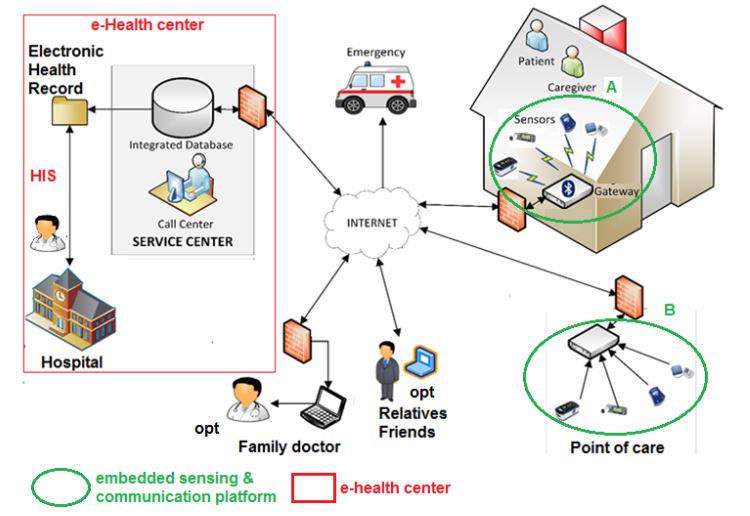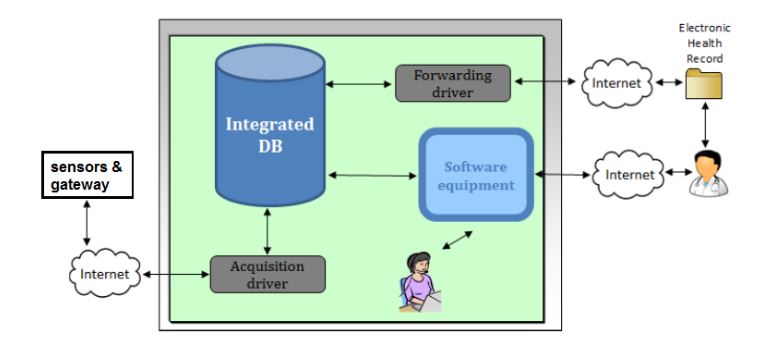ABSTRACT
This paper presents a new remote healthcare model, which, exploiting wireless biomedical sensors, an embedded local unit (gateway) for sensor data acquisition-processing-communication, and a remote e-Health service center, can be scaled in different telemedicine scenarios.
The aim is avoiding hospitalization cost and long waiting lists for patients affected by chronic illness who need continuous and long-term monitoring of some vital parameters. In the “1:1” scenario, the patient has a set of biomedical sensors and a gateway to exchange data and healthcare protocols with the remote service center. In the “1:N” scenario the use of gateway and sensors is managed by a professional caregiver, e.g., assigned by the Public Health System to a number N of different patients. In the “point of care” scenario the patient, instead of being hospitalized, can take the needed measurements at a specific health corner, which is then connected to the remote e-Health center.
A mix of commercially available sensors and new custom-designed ones is presented. The new custom-designed sensors range from a single-lead electrocardiograph for easy measurements taken by the patients at their home, to a multi-channel biomedical integrated circuit for acquisition of multi-channel bio signals, to a new motion sensor for patient posture estimation and fall detection. Experimental trials in real-world telemedicine applications assess the proposed system in terms of easy usability from patients, specialist and family doctors, and caregivers, in terms of scalability in different scenarios, and in terms of suitability for implementation of needed care plans.
REVIEW OF THE STATE OF THE ART AND MAIN CONTRIBUTIONS OF THE WORK
Several state-of-the-art wearable sensors and telemedicine platforms have been proposed in the literature, but a successful and universal healthcare model is still missing. The main reason is that most works are only focused on a specific sub-part of the system, or on a specific type of disease. For example, are focused on integrated smart sensors. Many studies are focused only on the acquisition and communication gateway or on the remote server connected to the hospital information system (HIS).
REMOTE HEALTHCARE MODEL AND EMBEDDED SENSING/COMMUNICATION PLATFORM

Figure 1. Distributed health care system for chronic illness monitoring
The key blocks in Figure 1 are:- A monitoring kit (embedded sensing and communication platform, oval A with green borders in Figure 1, whose description is detailed in Sections 3.1–3.3) which, depending if the “1:1” or “1:N” scenario is implemented, caregivers, e.g., nurses, during planned home visits.

Figure 2. Main building blocks of the gateway
The reference architecture of the biomedical monitoring kit is reported in Figure 2. It includes: a set of wireless sensors, connected through a Bluetooth wireless technology to an embedded system (called gateway) in charge of biomedical sensor signal acquisition, local processing, and data storage, and three interfaces: one for the user, one for the sensors, and the other for the e-Health center.
HOME MONITORING UNIT VS. E-HEALTH CENTER CLIENT–SERVER COMMUNICATION

Figure 8. Block diagram of the remote e-Health center
In the proposed health model the remote e-Health center in Figure 8 plays an essential role, since it integrates the services performed on the territory within the medical environment and the HIS. As reported in Figures 1 and 8, it includes a service center and the interface toward the HIS. The e-Health center is the central element of the overall modular system, in which specialized human operators and ICT resources allow for managing data flows and events.

Figure 9. Skin–electrode contact electric model
One of the most important aspects to be considered when using dry metal electrodes concerns the contact impedances of the electrodes with the skin, which represents the source impedances of the system. Figure 9 shows a simplified model of the skin–electrode contact impedance that presents resistive and capacitive components.
EXPERIMENTAL TRIALS

Figure 15. Aggregated feedback from patients
Table 5 and Figure 15 show the scores reached in each macro-parameter for medical staff and patients, respectively. Medical personnel reported that the use of this platform does not impinge on their regular activity, while it represents a valid means of controlling at a distance the progress of their patients thanks to the high quality of acquired signals and alarm detection capability. All specialist doctors are definitively in favor of the adoption of the platform. In addition, 89% of patients report a very high satisfaction level, highlighting the friendliness of the solution and the ease of following the daily therapy.
CONCLUSIONS
This paper has presented the implementation and experimental verification of a remote monitoring system including the whole value chain from the top (health care model) down to the technical implementations of sensors, data acquisition, processing, a communication platform (gateway), and integration with a service center and HIS. The proposed system is scalable in different telemedicine scenarios involving different roles for all the actors in a health system (patients, their family, nurses, doctors, institutions, local health corners, call center operators): to this end the “1:1,” “1:N,” and “point of care” scenarios are presented and discussed.
A mixture of commercially available sensors and new custom ones are presented and used. The new custom-designed sensors range from a single-lead ECG for easy self-measurements at home, to a multi-channel biomedical ASIC for acquisition of multi-channel bio signals (e.g., ECG, EEG, EMG), to a new motion sensor for patient posture estimation and fall detection. Specific focus has been placed on aspects such as the user interface and easy use of the device for non-professional users. From a communication point of view, BT and BLE wireless PAN links are used between sensors and gateway, whereas wireless LAN or wired technologies are used between the gateway and the remote server.
All data can be transferred though several protocols, including HL7 CDA. Experimental trials in real-world telemedicine applications assess the proposed system in terms of easy usability for patients, family members, specialist doctors, and caregivers; in terms of scalability in different scenarios; and in terms of suitability for the implementation of needed care plans. Since the number and type of patients involved in the reported experimental trials (see Sections 6.2–6.4) are still not enough to claim a complete survey and reliable statistics, there is ongoing experimental activity.
The aim of the ongoing activity is also to validate the efficacy, in terms of economic advantages and impact on the conventional organization of people and infrastructures, of the telemedicine scenarios for the PHS. The psychological acceptance of the telemedicine model from a large part of the population should also be validated. To this end, the telemedicine system can also be supported by a remote videophone service, exploiting compression technologies we already developed—thus the patient can also “see” the doctor. Moreover, ongoing activity is focused on implementing a reliable, automatic check of the quality of the acquired biomedical measurements.
Source: Pisa University
Authors: Sergio Saponara | Massimiliano Donati | Luca Fanucci | Alessio Celli
>> More Wireless Bluetooth Projects for Final Year Students
>> More Wireless Biomedical Projects for Engineering Students
>> More Wireless Embedded Projects for Engineering Students